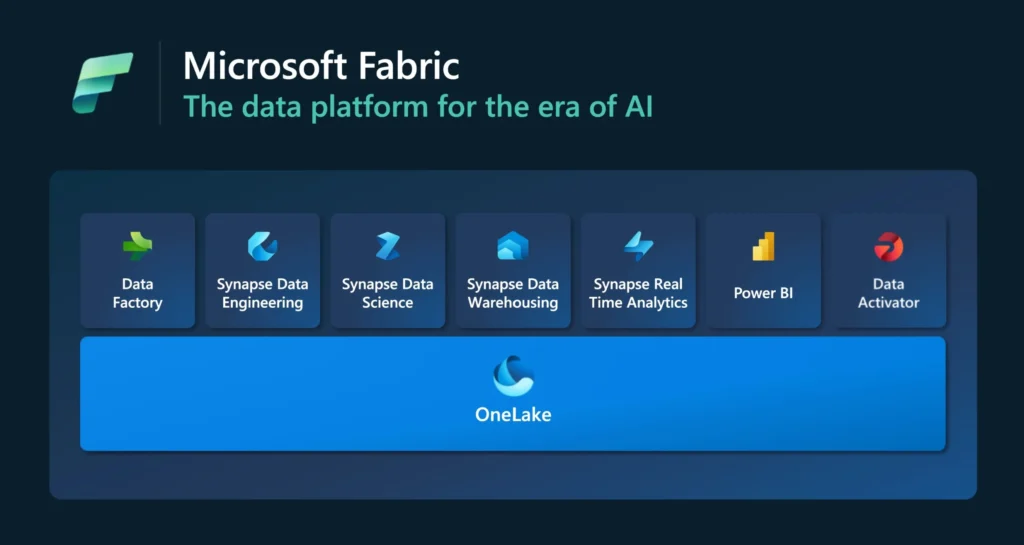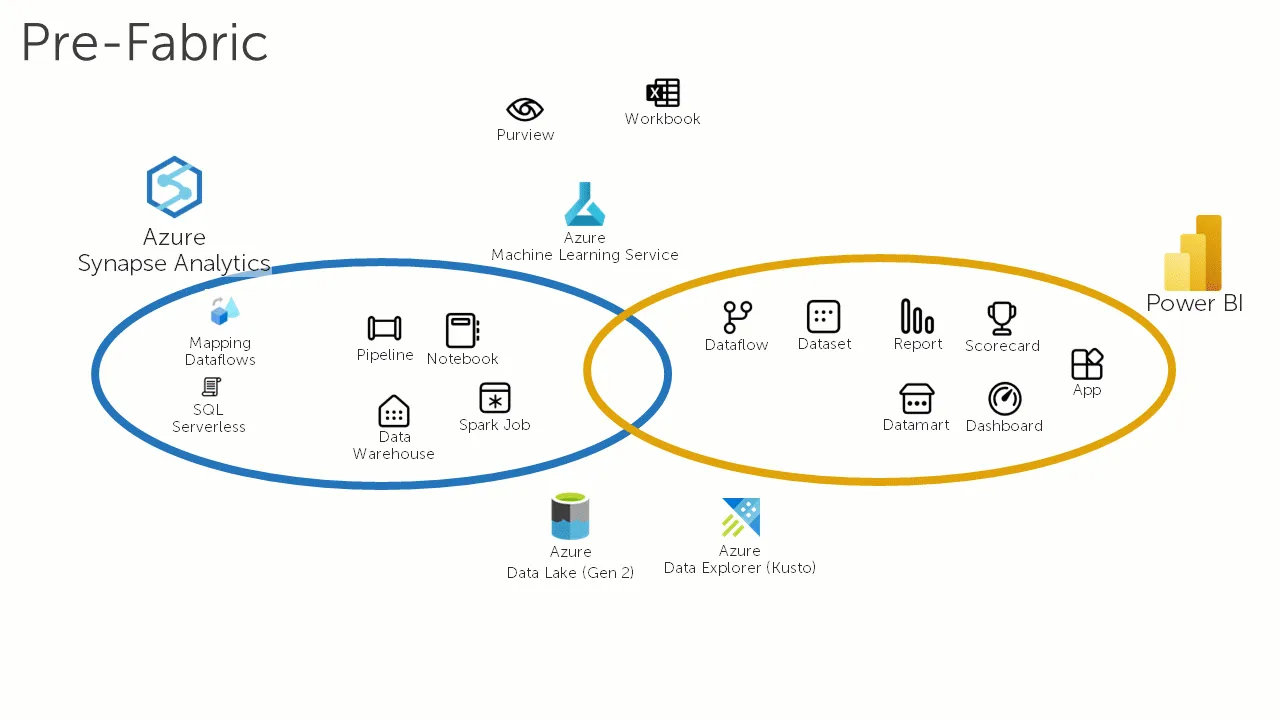
Introduction
Microsoft Fabric is a powerful and versatile platform that plays a crucial role in modern computing. Understanding Microsoft Fabric is essential for developers and IT professionals who want to leverage its capabilities to build scalable and reliable applications. Microsoft Fabric is a technology that will be discussed in this article. We will cover its history, structure, implementation, control, expansion, protection, connection with other Microsoft services, practical applications, and future prospects.prospects.
What is Microsoft Fabric?
Microsoft Fabric is a distributed systems platform that provides the foundation for building and running scalable and reliable applications. It abstracts the complexities of distributed systems and provides a set of tools and services that simplify the development, deployment, management, and scaling of applications. Microsoft Fabric is designed to handle the challenges of modern computing, such as high availability, fault tolerance, scalability, and agility.
Microsoft Fabric is built on the principles of microservices architecture, which allows applications to be broken down into smaller, independent components called microservices. These microservices can be developed, deployed, and scaled independently, enabling faster development cycles and better resource utilization. Microsoft Fabric also provides built-in support for stateful services, which allows applications to maintain their state across multiple instances and recover from failures seamlessly.
Evolution of Microsoft Fabric
Microsoft Fabric has evolved over the years to meet the changing needs of developers and IT professionals. One of the key milestones in the evolution of Microsoft Fabric is the introduction of Azure Service Fabric and Azure Kubernetes Service.
Azure Service Fabric is a fully managed platform that allows developers to build and deploy highly scalable and reliable applications. It provides rich features and tools for developing microservices-based applications, including support for stateful services, automatic scaling, rolling upgrades, and health monitoring. Azure Service Fabric also integrates seamlessly with other Azure services, such as Azure Container Instances and Azure Functions.
Azure Kubernetes Service (AKS) is a managed container orchestration service that simplifies the deployment, management, and scaling of containerized applications using Kubernetes. AKS provides a fully managed Kubernetes cluster, eliminating the need to manage the underlying infrastructure. It also integrates with other Azure services, such as Azure Container Registry and Azure Monitor.
While both Azure Service Fabric and Azure Kubernetes Service offer similar capabilities, there are some key differences between the two services. Azure Service Fabric is more suitable for building complex, stateful applications that require fine-grained control over the deployment and scaling of microservices. On the other hand, Azure Kubernetes Service is better suited for deploying and managing containerized applications that are built using standard Docker containers and Kubernetes.
Understanding the Architecture of Microsoft Fabric
The architecture of Microsoft Fabric is based on the concepts of nodes, clusters, and applications. A node is a physical or virtual machine that runs the Microsoft Fabric runtime and hosts one or more microservices. A cluster is a group of nodes that work together to provide high availability and fault tolerance for the applications running on them. An application is a collection of microservices that work together to provide a specific functionality.
In the Microsoft Fabric architecture, each microservice is deployed as a separate process and can be scaled independently. The microservices communicate with each other using reliable messaging protocols, such as TCP/IP or HTTP. Microsoft Fabric provides built-in support for service discovery, load balancing, and failover, making building highly available and scalable applications easy.
One of the key benefits of using the Microsoft Fabric architecture is its ability to handle failures gracefully. If a node or a microservice fails, Microsoft Fabric automatically detects the failure and takes appropriate actions to recover from it. It can restart failed microservices, redistribute the workload across healthy nodes, and maintain the availability of the application.
Deploying Applications on Microsoft Fabric
Deploying applications on Microsoft Fabric involves several steps, including packaging the application, creating a cluster, deploying the application to the cluster, and configuring the application.
To package the application, developers must create a package containing all the necessary files and dependencies required to run the application. This package can be created using tools like Visual Studio or the Microsoft Fabric CL
Once the application is packaged, developers can create a cluster using the Azure portal or the Microsoft Fabric CL
The cluster can be created on-premises or in the cloud, depending on the requirements of the application. The cluster consists of one or more nodes that will host the microservices of the application.
After the cluster is created, developers can deploy the application to the cluster using the Azure portal or the Microsoft Fabric CL
The deployment process involves uploading the application package to the cluster and specifying the desired number of instances for each microservice.
Finally, developers can configure the application by setting up environment variables, configuring service endpoints, and defining health checks. These configurations can be done using the Azure portal or the Microsoft Fabric CL
When deploying applications on Microsoft Fabric, it is important to follow best practices to ensure a smooth deployment process. Some best practices include using version control for application code, automating the deployment process, using rolling upgrades for seamless updates, and monitoring the health of the application during and after deployment.
Developers may encounter common issues during deployment include compatibility issues with dependencies, configuration errors, and resource constraints. To troubleshoot these issues, developers can use tools like Visual Studio, Azure Monitor, and the Microsoft Fabric CL
Managing and Monitoring Microsoft Fabric
Managing and monitoring Microsoft Fabric is essential to ensure the availability and performance of applications running on it. There are several best practices that developers and IT professionals can follow to manage and monitor Microsoft Fabric effectively.
One best practice is to use automation tools to manage the lifecycle of applications running on Microsoft Fabric. Automation tools like Azure DevOps and Jenkins can be used to automate tasks such as deployment, scaling, and monitoring of applications. This helps to reduce manual errors and improve the efficiency of the management process.
Another best practice is to use monitoring tools to track the health and performance of applications running on Microsoft Fabric. Azure Monitor provides comprehensive monitoring capabilities, including metrics, logs, and alerts. Developers and IT professionals can use these monitoring capabilities to identify performance bottlenecks, troubleshoot issues, and optimize the performance of their applications.
Common issues that developers and IT professionals may encounter when managing and monitoring Microsoft Fabric include resource contention, network connectivity issues, and performance degradation. To troubleshoot these issues, they can use tools like Azure Monitor, Azure Network Watcher, and the Microsoft Fabric CL
Scaling and Updating Applications on Microsoft Fabric
Scaling and updating applications on Microsoft Fabric can be challenging due to the distributed nature of the platform. However, developers and IT professionals can use several solutions and best practices to overcome these challenges.
One solution is to use automatic scaling to dynamically adjust the number of microservices instances based on the workload. Microsoft Fabric provides built-in support for automatic scaling, which allows developers to define scaling rules based on metrics such as CPU usage or request rate. This helps ensure the application can handle varying levels of traffic without manual intervention.
Another solution is to use rolling upgrades to update applications without downtime. Rolling upgrades allow developers to update microservices one at a time, while the rest of the application runs. This helps to minimize the impact of updates on the availability of the application and provides a seamless experience for users.
Some best practices for scaling and updating applications on Microsoft Fabric include using horizontal scaling to add more nodes to the cluster, using vertical scaling to increase the resources allocated to each node, and using canary deployments to test updates on a small subset of users before rolling them out to the entire application.
Common issues that developers and IT professionals may encounter when scaling and updating applications on Microsoft Fabric include performance degradation, resource constraints, and compatibility issues. To troubleshoot these issues, they can use tools like Azure Monitor, Azure Advisor, and the Microsoft Fabric CL
Security and Compliance in Microsoft Fabric
Ensuring data protection and compliance is crucial when using Microsoft Fabric to build and run applications. There are several best practices that developers and IT professionals can follow to enhance the security and compliance of their applications running on Microsoft Fabric.
One best practice is to use encryption to protect sensitive data in transit and at rest. Microsoft Fabric provides built-in support for Transport Layer Security (TLS) encryption, which can be used to secure communication between microservices. Developers can also use Azure Key Vault to store and manage encryption keys and secrets.
Another best practice is implementing access control and authentication mechanisms to restrict access to applications running on Microsoft Fabric. Azure Active Directory can be used to authenticate users and control their access to resources. Role-based access control (RBAC) can be used to assign permissions to users based on their roles and responsibilities.
Compliance requirements for applications running on Microsoft Fabric may vary depending on the industry and the type of data being processed. Some common compliance requirements include General Data Protection Regulation (GDPR), Health Insurance Portability and Accountability Act (HIPAA), and Payment Card Industry Data Security Standard (PCI DSS). Developers and IT professionals should ensure that their applications comply with these requirements by implementing appropriate security controls and conducting regular audits.
Integrating Microsoft Fabric with Other Microsoft Services
Integrating Microsoft Fabric with other Microsoft services can provide additional capabilities and enhance the functionality of applications. Integrating Microsoft Fabric with other services, such as Azure, Visual Studio, and Azure DevOps, has several benefits.
One benefit is the ability to leverage the scalability and reliability of Azure when running applications on Microsoft Fabric. Azure provides a wide range of services, such as Azure Storage, Azure Cosmos DB, and Azure Functions, that can be used to store data, process events, and perform other tasks. Integrating Microsoft Fabric with Azure allows developers to use these services and build more robust and scalable applications.
Another benefit is the seamless integration with Visual Studio, a popular development environment for building applications. Visual Studio provides rich tools and features for developing, debugging, and deploying applications on Microsoft Fabric. Developers can use Visual Studio to create and manage microservices, package applications, and deploy them to Microsoft Fabric clusters.
Integrating Microsoft Fabric with Azure DevOps allows developers to automate the deployment and management of applications. Azure DevOps provides tools and services for continuous integration and continuous deployment (CI/CD), which can be used to automate the build, test, and deployment processes. This helps to reduce manual errors and improve the efficiency of the development lifecycle.

Real-World Use Cases of Microsoft Fabric
Several real-world use cases exist of companies using Microsoft Fabric to build and run their applications. These companies have experienced significant benefits by leveraging the capabilities of Microsoft Fabric.
One example is GE Healthcare, which used Microsoft Fabric to build a cloud-based platform for managing medical imaging data. The platform allows healthcare providers to securely store, access, and analyze medical images from anywhere. Using Microsoft Fabric, GE Healthcare achieved high availability, scalability, and performance for their platform.
Another example is Schneider Electric, a global energy management and automation leader. Schneider Electric used Microsoft Fabric to build a distributed energy management system enabling real-time energy asset monitoring and control. The system helps Schneider Electric’s customers optimize energy consumption, reduce costs, and improve sustainability.
These companies have learned several lessons from their experience with Microsoft Fabric. One lesson is the importance of designing applications for scalability and fault tolerance from the beginning. By following best practices for building distributed systems, such as microservices and stateful services, these companies achieved high availability and scalability for their applications.
Future of Microsoft Fabric
The future of Microsoft Fabric looks promising, with several exciting developments on the horizon. Microsoft is continuously investing in the platform to enhance its capabilities and address the evolving needs of developers and IT professionals.
One area of focus for Microsoft is the integration of Microsoft Fabric with other Azure services. Microsoft is improving the integration with Azure Kubernetes Service, Azure Functions, and Azure Logic Apps to make it easier for developers to build applications on Microsoft Fabric.
Another area of focus is the support for hybrid and multi-cloud deployments. Microsoft is working on enabling applications running on Microsoft Fabric to seamlessly span across on-premises data centers and multiple cloud providers. This will provide more flexibility and choice for organizations that want to leverage the benefits of Microsoft Fabric in a hybrid or multi-cloud environment.
Microsoft is also investing in improving the developer experience for building applications on Microsoft Fabric. This includes providing better tooling, documentation, and training resources to help developers get started quickly and build high-quality applications.
Conclusion
In conclusion, understanding Microsoft Fabric is essential for developers and IT professionals who want to build scalable and reliable applications. Microsoft Fabric provides a powerful platform for building and running distributed systems, with features and tools that simplify application development, deployment, management, and scaling. By following best practices and leveraging the capabilities of Microsoft Fabric, organizations can build highly available, scalable, and secure applications. With the continuous investment from Microsoft and the growing adoption of Microsoft Fabric, the future looks bright for this powerful platform.




